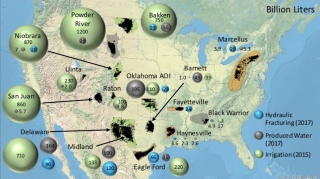Can We Beneficially Reuse Produced Water from Oil and Gas Extraction in the U.S.?

Bridget R. Scanlon, Robert C. Reedy, Pei Xu, Mark Engle, J.-P. Nicot, David Yoxtheimer, Qian Yang, and Svetlana Ikonnikova
Science of the Total Environment, https://doi.org/10.1016/j.scitotenv.2020.137085
Study Summary
There is considerable interest in beneficial use of produced water (PW) from oil and gas plays outside of the energy sector. However, many basic questions need to be resolved to assess the feasibility of beneficially reusing the PW.
- How much PW is available for reuse, and how do these volumes compare with water demands in different sectors?
- What is the quality of the PW, and how does it impact reuse options?
In this study, we quantified PW volumes from major unconventional oil and gas (UOG) plays and compared those with 2015 water demand for irrigation, municipal use, and other sectors. We evaluated PW quality from the USGS Produced Waters Database and the literature and examined treatment options for PW.
Results of the analysis indicate that PW volumes from UOG reservoirs for 2017 totaled ~600 billion liters (BL, 160 Bgal). One year of PW is equivalent to ~60 percent of one day of freshwater use in the U.S. (excluding the thermoelectric sector). Reuse of PW for hydraulic fracturing (HF) within the energy sector would reduce total PW volume because only half of the plays have PW in excess of HF water. PW from coal bed methane (CBM) reservoirs is ~10 percent of that from UOG plays (46 BL [12 Bgal] in 2017). Irrigation exceeds PW volumes from UOG plays by ~5×. While irrigation can accommodate PW at the county scale in most plays, PW would mostly only constitute ~1 percent of irrigation in counties with large irrigation demands. Irrigation exceeds PW from CBM plays by ~50×. Therefore, PW would not substantially alleviate water scarcity related to irrigation demands. Municipal water use is ~2× PW from UOG reservoirs but locally greatly exceeds PW where municipal demands are high. PW quality is variable, with median total dissolved solids (TDS) up to 244 g/L in the Bakken (~7× TDS of seawater). The high TDS of PW generally requires thermal distillation, which is expensive and energy intensive. Desalinating PW would result in large volumes of concentrate for disposal, or treatment to zero liquid discharge with solids. For example, the salts that would result from PW from the Permian Delaware Basin in 2017 would represent ~3,000 Olympic swimming pools of salt, assuming 100 g/L TDS. Large knowledge gaps about PW quality, treatment efficiency, lack of regulations designed specifically for PW, and economic factors currently preclude beneficial use of PW outside of the energy sector. The issues identified with beneficial use of PW outside of energy underscore the need to maximize reuse within the energy sector to alleviate water scarcity related to water demands for HF and other adverse impacts.
Why is this research important and why do the results matter?
-
Quantifying the volumes of PW from UOG reservoirs and comparing these volumes to water demand in different sectors is the first step in assessing the potential for beneficial use of PW outside the oil and gas sector.
-
Although data on PW quality are limited, the information on PW salinity provides valuable input into appropriate treatment technologies. The current assessment of PW quality allows identification of knowledge gaps about water quality that present a barrier to beneficial reuse outside of the energy sector.
-
This research highlights many additional factors that need to be considered to assess the feasibility of beneficial use of PW outside of energy, including (1) detailed characterization of PW quality, (2) assessment of the efficiency and reliability of desalination, (3) risk assessment to minimize adverse impacts to humans and ecosystems, and (4) regulations to address reuse in other sectors.